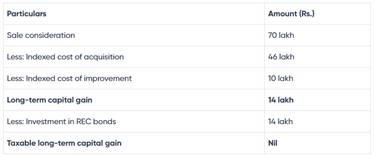Capital gain bonds or 54EC bonds are fixed income instruments that provide capital gains tax exemption under section 54EC to the investors. The tax liability on long-term capital gains from sale of immovable property can be reduced by purchasing 54EC bonds.
These bonds are issued by infrastructure companies that are backed by the government. Hence, the risk factor gets mitigated by buying such bonds. The capital gain bonds are redeemable before maturity. One cannot sell these bonds as they are not listed in the stock exchange.
Bonds eligible for exemption under section 54EC of the Income Tax Act
Rural Electrification Corporation Limited or REC bonds,
National Highway Authority of India or NHAI bonds,
Power Finance Corporation Limited or PFC bonds,
Indian Railway Finance Corporation Limited or IRFC bonds.
Key Facts
To avail the tax-exemption, the investment must be made within 6 months of the date of sale of immovable property.
Such investment can be redeemed only after 5 years. Prior to April 2018, the bonds could be redeemed within 3 years.
The exemption on investment is allowed only against long term capital gains on sale of immovable property (i.e. sale of land or building).
The exemption is available up to a maximum amount of Rs 50 lakh
How to calculate the tax exemption by investment in tax saving bonds
Scenario 1:
Scenario 2:
How to make investment in 54EC bonds
These bonds are not listed in the stock exchange. Hence you can buy them by the issuer directly either in a demat form or a physical form. Let us understand how to invest in the above mentioned bonds:
Step 1: Download the respective bond Form from here
Step 2: Choose the direct option on the download page.
Step 3: Select the number of forms to download.
Step 4: Enter the captcha and download.
Step 5: The form downloads in ZIP format.
Step 6: Unzip and extract the form
Step 7: Print the form and fill as per the given instructions.
Step 8: Investors should attach either a demand draft or account payee cheque and necessary enclosures at the designated branches of collecting banks: Axis Bank, Canara Bank, State Bank of India, HDFC Bank, ICICI Bank, IDBI Bank, IndusInd Bank or Yes Bank.
Step 9: You can also directly deposit the amount in the respective collection account by way of NEFT/RTGS and invariably fill the application forms as given on the website online and mention the UTR no. at space provided in the application form.




